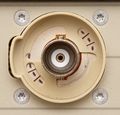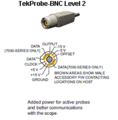Tekprobe BNC connector

The Tekprobe BNC interface was introduced in 1986 and is widely used in 1990s Tektronix equipment to interface active probes (e.g. the P6243) to oscilloscopes. It is a downward-compatible successor to the BNC connector with readout ring used in earlier instruments like the 7000 series scopes.
It consists of a plain BNC connector that allows traditional BNC based connections such as from passive probes. (See Patent US 4708661A.)
This connector is surrounded by contact pads carrying power and data. The two larger pad areas match the simple resistive readout pins, with division factors encoded as resistance to ground, although TekProbe BNC-era instruments accept values that earlier instruments did not.
The smaller pads carry +15 V, +5 V, −5 V and −15 V power, an offset voltage (-1 V to +1 V) supplied and controlled by the mainframe, and a clock/data signal pair for serial communication between the mainframe and "smart" probes. Probes are allowed to draw max. 1.25 W, max. 75 mA from the ±5 V rails, and max. 25 mA from the ±15 V rails.
A similar standard exists based on SMA connectors, suitable for higher frequencies.

Used in
| Scopes | Plug-ins | Probes |
|---|---|---|
Links
- What is the TekProbe interface? (Tektronix FAQ)
- What is the difference between the Tekprobe and TekConnect probe interfaces? (Tektronix FAQ)
- A USB power supply for the tekprobe interface




